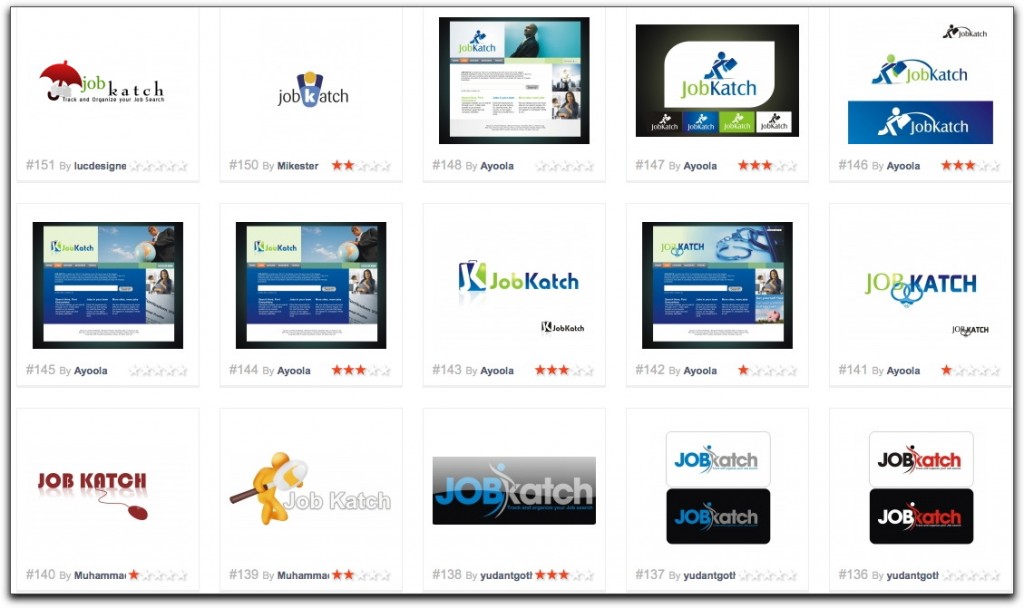There’s two trends – the Cloud and the Crowd – afoot in the software world, and if these trends have gotten buried by all the day to day trivia, let me give you a quick rundown on how they’re changing our industry.
Way back say two years ago, one of the first checks you’d write launching your startup would be to a graphic artist for a couple thousand dollars to execute your new company’s logo. It wouldn’t be cheap, but it would be good and they’d been recommended to you as someone who did good startup logos.
Now what you’d do is spend $39 at 99designs.com to post a design contest for your new company logo for say 1/4 of what you would have paid and let the crowd of 31,000 graphic artists submit designs to you. Then watch as 56, 92 or 124 (actual numbers) designers submit logos for your consideration. Joe the Graphic Artist might be good, but is he better than a hundred other graphic artists?
Once you had your logo, you could move on to designing the app. The way it used to be is that while everyone in this business knows usability testing makes for a better product, corralling testers off the street was a hassle and most of the usability testing companies charged about $250 per test per testee – too expensive a meal for most startups.
But that was then and this is now and now there’s at least one company – UserTesting.com – that has created a crowd of willing testers and the infrastructure to let them remotely test your software or site and send you the video, with their comments and a report – for $19 a pop. Now, finding out whether real people can prefer Interface A or Interface B isn’t worth a three hour argument: you just find out.
Take another part of the software creation puzzle: load testing. It’s another one of those “nice to have, but it’s really expensive” things that used to never get done in most startups. Then along came BrowserMob, that will happily spin up a couple thousand virtual users for pennies on the dollar of what that used to cost. Oh, you want actual instances of a real web browser putting your site through its paces? They can spin those up for you too, again, for a fraction of what other load testing companies charge.
Or consider another form of testing: finding bugs in your software. The old way of doing this is you’d hire 3 or 4 testers to pound on your app, upset your programmers and generally uncover all the bugs that crept into your codebase during development. The new way? You go to uTest, who provides on-demand software testing via their crowd of some 15,000+ testers for about a quarter of the cost of traditional in-house testing.
So far, we’ve been talking about the sudden emergence of disruptively-price crowd-powered companies. That’s half of the new equation, and as the global economy continues to shed jobs, those specific crowds are going to have a lot more people in them. But the Crowd is only half of the story: The Cloud is the other half.
I’m going to get a bill in a day or so for about $20 – That’s what it will have costed to serve out to several thousand listeners a podcast I and Pat Foley do each week called The Startup Success Podcast. Compare that $20 to about $300 a month from established content serving companies who run vast server farms to spew out the bits you’re browser, or iTunes or other media receiver get. That’s the Cloud – specifically Amazon Simple Storage Service (S3) at work.
You’ve probably heard of S3, but here’s a few things you may not know:
- Amazon S3 launched 3 years ago – that’s a long time on the net to be building momentum.
- 3S now stores besides my 20 mp3 podcasts another 52 billion files, and handles over a trillion requests a year.
- Amazon Web Services as a whole has a huge customer base in 90 countries: as of a year ago, 60,000 customers, most not startups.
- Amazon Web Services uses more bandwidth than Amazon.com.
The Cloud is about much more than just storage – for example, BrowserMob uses Amazon E2C virtual servers as the backbone of its company. The idea of virtualized servers of any flavor (including Windows) in the Cloud has moved from IT development plaything to an extremely attractive option and is heading towards being a utility – something you just assume you’ll pay for instead of make yourself, like electricity.
While Amazon is the largest Cloud vendor (and you thought they just sold things), they are by no means the only: IBM, Microsoft, Google, Cisco, Intel and other mainline IT companies have been ramping up their own Cloud offerings. Lots of vendors equals competition equals even lower prices equals even more attractive.
Doing business in the Cloud and with Crowds isn’t total bliss: I’d like to have told you exactly how much my March bill for S3 is, but I can’t get that yet; the quality of graphic artists, usability and black box testers varies widely. All things considered, as these Cloud and Crowd vendors mature, proliferate and disrupt more and more of the traditional ways software gets built and served, it’s worth your time to keep an eye out for how they might reshape your company – or your competitor’s.






